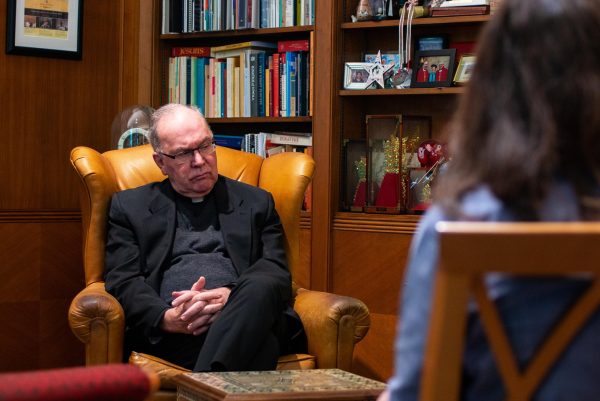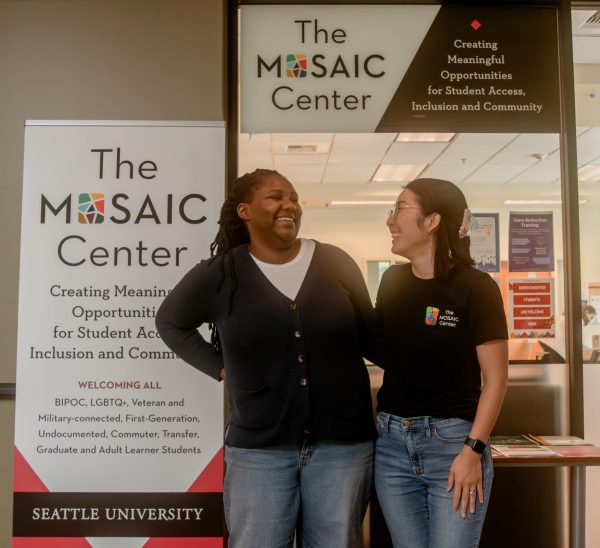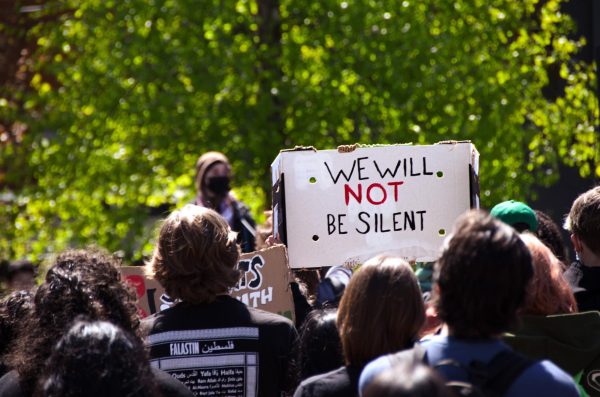What is the New Normal in Classrooms?
From top left to right: Dr. Natalie Welch, Dr. Yancy Dominick, Dr. Alexandra Smith. From bottom left to right: Dr. David Boness, Dr. Jeff Philpott, Dr. Michael Ng.
Are attendance and participation in college courses considered a given in a “post-pandemic” world? Seattle University professors have noticed more students being distracted, avoiding participation and being unprepared for class. Others have not seen the same change.
David Boness, physics professor at Seattle U, taught eight different courses on Zoom throughout the pandemic and hasn’t seen abnormal changes in course engagement. For his physics classes, participation suffered during the pandemic because there were fewer hands-on and student-led demonstrations of solutions. Upon return to full-time classroom instruction, these problems were resolved. Boness also taught sections in the Honors program across quarters before, during and after the pandemic.
“With those three time periods, the students are pretty much the same… the honors students would all have their cameras on, and they were speaking up so it wasn’t different in terms of student participation. It was different because we’re all looking at screens, and we’re not in the same room together,” Boness said.
Jeff Philpott, director of the University Core (UCOR) at Seattle U, sent out a survey to faculty teaching UCOR classes last quarter to understand how they were feeling about the return to in-person instruction. The responses he received indicated that some professors have noticed a decline in skills like sustained reading and writing.
“In general, faculty are telling me that the first-year students are showing up really engaged… in contrast, continuing students are less engaged. That doesn’t mean they weren’t doing well in class, but they were just a bit more remote, a bit harder to engage in discussion,” Philpott said.
For Boness, differences disappeared upon a return to in-person instruction, but other professors are trying to understand changes in their sections. Part of the issue professors have seen with the return to in-person classes is that the COVID-19 pandemic is still taking its toll on people with health complications and the elderly, along with those experiencing “long COVID,” which may prolong symptoms such as fatigue. With these factors complicating how students live, professors say there are additional issues affecting their learning.
Continuing students may be experiencing a degree of fatigue that continues outside of the boundaries of an official pandemic. The 2022-2023 academic year has provided more in-person instruction than years past, and commuter students who could have gotten by with hybrid or online classes are often now expected to return to in-person learning.
Additionally, students are wrestling with their mental health on some of the dreariest days of the year. Michael Ng, history professor at Seattle U, noticed that his students are communicating more frequently with him about their mental health and are better equipped to fight burnout than in previous years. His classes are not at pre-pandemic levels of attendance, but his students remain involved with class through email and asking classmates for notes.
“I’d rather have a student back when they’re fully able to engage rather than not learning the material and sitting passively in class,” Ng said.
Professors in schools besides the College of Arts and Sciences have also seen an uptick in students being more transparent with professors about strain. Natalie Welch, marketing professor in the Albers School of Business and Economics, receives similar emails from students regarding mental health days.
Welch started teaching classes at Seattle U in the fall after her experience instructing smaller class sizes and shorter class times. She introduces periodic videos and class discussions into her lectures to break up two hours of class time. Even so, distractions, like phones, are still a problem to be addressed in the classroom.
Welch resisted a blanket solution like banning phones because she believes it doesn’t adequately prepare students for the professional world where self-discipline is necessary. Keeping the business environment in mind, Welch also knows that valuable contributions in class are more important than simply showing up.
“I used to get great attendance but then I realized that it’s not just about being here, right? It’s about participating, being prepared and being present… so I changed my attendance grade to an ‘engagement’ grade,” Welch said.
Changes to grading often reflect feedback from students in conversation with their professors. Welch’s multimodal lectures can be difficult to sustain for a full two hours, which she believes is another effect of prolonged virtual learning.
One way professors break up long class lectures is through peer engagement for a short period of time. In some ways, the “breakout group” is a facet of virtual learning that was adopted into in-person classes. Yancy Dominick, a professor of philosophy at Seattle U associated with the honors program, features “pair-and-share” activities that provide a change of pace in a long class period with one-on-one student discussion.
“I’m not sure how much of it is due to the pandemic and how much is trying to find ways to invite students who might not have been comfortable speaking in large groups, even before the pandemic, so they still feel like they’re participating,” Dominick said.
Dominick also uses Canvas in some of his classes to emulate the feel of a Zoom chat box by having a virtual discussion open during class for students that are less comfortable with speaking up.
In addition to attendance and participation in class discussions, elements of assignments such as research papers and essays appear to have changed in recent years as well. Alexandra Smith, English professor at Seattle U, introduced a labor-based grading contract in the fall of 2020 in response to the highly subjective nature of what makes a “quality” piece of writing. The contract assesses the work put into an assignment in addition to the quality. The work is measured off of concrete parameters such as word count or the presentation of a thesis statement.
Smith employs these contracts in her Academic Writing Seminar at the UCOR 1100 level, to some success. Philpott’s faculty feedback indicated that students don’t perform as well on longer assignments in recent years, so Smith’s approach to grading could be one way to build a strong basis for higher UCOR levels.
In addition to the labor-based grading contract, Smith provides students with feedback to workshop the writing’s quality instead of penalizing students on subjective parameters. She implemented the grading contract based on what she had seen as an assistant director for Seattle U’s Writing Center. The uptick in no-shows and abrupt cancellations for Writing Center appointments is in-line with the fatigue that students are feeling in other areas, but they also appear to be struggling with gathering the stamina to write papers.
“The ability to do something like a writing assignment is impacted… I get the sense that students get overwhelmed and paralyzed,” Smith said.
Building the stamina in early UCOR levels is one way that professors are hoping students expand beyond assignments like one-page reaction essays and into a longer thesis-driven essay format. Philpott’s faculty survey reveals that professors are impressed with students’ ability to make cross-textual analyses, but need help formalizing those ideas into papers.
A variety of issues have appeared in higher education in the wake of a worldwide pandemic, but a consistent current runs through each professor’s observations, even in situations where class has returned to normal.
People are tired, faculty and students alike. How professors respond to their students’ chronic fatigue and their own in the coming quarters will shape future teaching techniques.
“I think a lot of professors are very tired… The rapid transition to online education, converting what you’ve done in a lifetime into something you can put on Zoom, was exhausting for faculty members,” Philpott said.
For professors like Ng, taking students out of the classroom is one way to improve morale. He takes UCOR and Honors students to the International District to consider the history of various cultures’ presences in Seattle—and to eat delicious food.
“If the university’s Jesuit values are about caring for the whole person, then that’s what we need to do,” Ng said.
Professors helping the new generation of students grow are aware of the challenges innate to the world today: ongoing fatigue, a rising mental health crisis and atrophy of important skills all contribute to the difficulties that students and professors are facing.
“You’ve got to teach the students who are in front of you, and that means thinking about how to reach them where they are, and how you make what you’re teaching relevant to their world,” Philpott said.m
Some classes may return to a pre-pandemic normal, but too many have indisputably changed in order to go unnoticed. As of yet, there is no blanket solution for ensuring that students come to class, do their work and feel supported in the Seattle U community. The variety of needs represented by Seattle U students and faculty requires a myriad of solutions that are tested for our current world.











